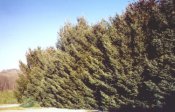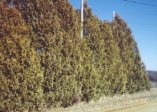OUR FAVORITE WINDBREAK DESIGN FOR THE MIDWEST TO THE EAST COAST.
WE DO REALIZE EVERY SITUATION IF DIFFERENT. You may not have room for several rows of trees. Let us know what your situation is and we can go on goggle earth and look at your place and come up with the best plan for you. E-mail me at: kkelly6300@gmail.com
OUTSIDE ROW--WINDWARD-THE SIDE THE WIND HITS FIRST.
AUSTREE WILLOW
8 year old Austree willow row—40 ft tall
AUSTREE WILLOW: These deciduous trees grow very fast of up to 8 ft per year, have leaves early in April and hold them to November. Austrees helps the evergreens on the inside grow about 20% faster because they offer them protection from the wind during the critical spring growing season. They make a great snow catcher, and block the wind by 30% even in the winter, they do well the first 20 years, and top out at about 40 ft tall in 7 years. On most applications we recommend they be planted about 10 ft apart in a single row, or a double row spaced 10 ft apart in the row and 10 ft between rows. Click on our link for more info on the Austree Willow.
One year growth from potted tree, 4 ft to 12 ft in one year.
SECOND ROW 25 FT INSIDE OF AUSTREE WILLOW, USE TECHNY ARBORVITAE.
Techny Arborvitae
TECHNY ARBORVITAE: If you have any type of soil except for sandy or rocky we recommend the Techny Arborvitae. They are an excellent, dense plant that has a medium rate of growth, and live a long time. Space these a minimum of 12 ft apart in the row, we think 12-14 ft is better for the long term. Eastern Red Cedar is also a good choice for this row, it is native and a tough tree. See our link to the Techny Arborvitae for more info.
Third and Forth row 20 ft inside of Cedar or Arborvitae row use European Larch for the third row, or Norway Spruce for inside or both rows.
NORWAY SPRUCE: If you have almost any soil except sandy or rocky, space these rows twenty feet apart from the Techny and 20ft between these two rows. Space these 20 ft or farther apart in the row and use two rows of Norway Spruce. Although not native to America, no other tree does as well or lives as long as the Norway Spruce in windbreaks. Many of the oldest and largest evergreens in the northern half of North America that are used for windbreaks are the Norway Spruce. Visit: www.norwayspruce.com
Between the rows of newly planted evergreen tree windbreak, is an excellent place to raise a garden, berry bushes or even X-mas trees. Nothing permanent past 10 years should be planted in this area as it will need to be removed so the evergreens can continue to have space to grow.
These other evergreen or deciduous windbreak trees listed also work well in 3rd or 4th or more rows. Red Cedar, Canaan fir, European Larch and White Spruce.
If you are considering planting Colorado Blue Spruce, Black Hills Spruce, Concolor Fir, Austrian Pine, Red Pine, or Scotch Pine. These evergreen species although used extensively in the past, are not recommendation for a long lived windbreak as they can suffer from extensive disease, soil, and insect problems in many areas of the US east of central Nebraska.
There is also many kinds of deciduous shrubs that can be used in windbreaks as well.





